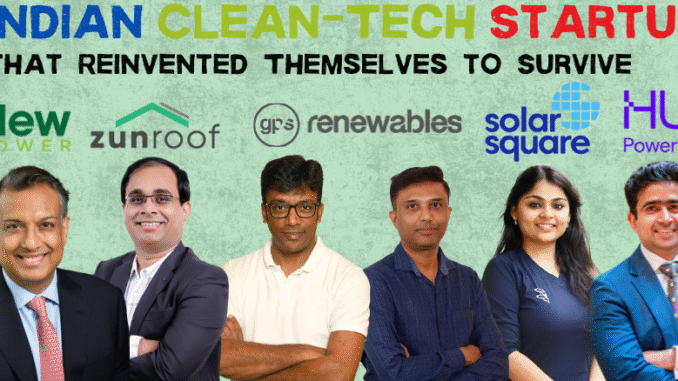
In India’s $2 trillion energy transition—a market where policy shifts overnight and consumer behavior defies prediction—the companies capturing outsized market share aren’t the ones with the best initial strategy. They’re the ones bold enough to abandon it.
SolarSquare: From B2B to “Har Ghar Solar”
Between 2015 and 2020, Shreya Mishra and co-founders built SolarSquare into a respected B2B solar installer with clients like Panasonic and Johnson & Johnson. But each commercial project required months of negotiation and customized engineering—a structural growth ceiling. In 2020, they pivoted to residential solar with standardized “Har Ghar Solar” kits installable in hours, not days.
By September 2025: 25,000+ homes powered, 100 MW residential capacity, revenue nearly doubled in FY25, and a $40 million Series B at ₹1,830 crore valuation. The shift from project-based to product-based scalability unlocked India’s fragmented $50 billion residential opportunity.
Husk Power: From Biomass to Hybrid Minigrids
When Manoj Sinha founded Husk Power in 2008, the model was simple: convert rice husk waste into electricity for off-grid Bihar villages. By 2015, 80 plants served 250,000 people. But customers evolved—they wanted 24/7 power for refrigerators and businesses, not just evening lighting.
Rather than incremental improvements, Husk integrated solar PV and battery storage with biomass plants, creating hybrid minigrids. The PRISM containerized solution cut CAPEX by 7% and OPEX by 20%. Results: 400+ minigrids (one per day installed in 2024), 1.5 million customers, world’s largest private operator, and a $400 million fundraise planned for 2027 IPO.
GPS Renewables: From BioUrja to National Infrastructure
IIM-Bangalore alumni Mainak Chakraborty and Sreekrishna Sankar launched GPS Renewables in 2012 with “BioUrja”—captive biogas plants for hotels and campuses. Over 100 units deployed successfully. But India needed biofuel infrastructure at national scale, not individual installations.
Between 2019-2020, GPS pivoted to large-scale CBG, 2G ethanol, and SAF projects. October 2025: their IOCL joint venture secured ₹836 crore debt for nine new CBG plants. FY24 revenue: $60 million—225% growth—with workforce scaling from 72 to 500+ employees. Target: 30 biomethane plants by FY27 producing 160,000 tons annually.
Zunroof: From One-Time Sales to Smart Home Ecosystem
Founded in 2016 by IIT-Kharagpur alumni Pranesh Chaudhary, Sushant Sachan, and Kartik Marwah, Zunroof made solar installation seamless. But one-time transactions meant no recurring revenue or ongoing customer relationships.
In 2020, they launched “zunpulse”—50+ IoT smart home devices spanning lighting, security, and energy efficiency. FY24 revenue dipped to ₹26.43 crore as they focused on sustainable economics, but net losses cut 51%. Godrej Family Office now holds 70% stake after ₹25 crore September 2025 round. The pivot: from low-margin transactions to high-margin, recurring platform revenue across 100,000+ homes.
ReNew: From Power Producer to Decarbonization Platform
Sumant Sinha (former Wall Street banker, ex-CFO Aditya Birla Group and Suzlon) founded ReNew Power in 2011 as a traditional renewable IPP—build wind/solar farms, sell electricity via PPAs. Goldman Sachs invested; the company listed on Nasdaq in 2021 as India’s largest independent renewable producer.
By 2023, Sinha recognized corporate customers needed more than green electrons—they needed carbon credits, green hydrogen, storage, and emissions accounting. ReNew rebranded to a holistic decarbonization platform: 18.5 GW portfolio across 150+ projects, green hydrogen JV with IOCL/L&T, ESG score of 73 (S&P Global), A- CDP rating, and net-zero target: 2040—30 years ahead of India’s goal.
| Company | Founded | Leadership | Original Model | Strategic Pivot | Current Scale & Impact |
| SolarSquare | 2015 | Shreya Mishra, Neeraj Jain, Nikhil Nahar | B2B C&I Solar Projects | B2C Residential Solar with standardized kits | 25,000+ homes; 100 MW residential; ₹1,830 crore valuation |
| Husk Power | 2008 | Manoj Sinha | 100% Biomass Gasification | Hybrid Microgrids (Solar + Biomass + Storage) | 400+ minigrids; 1.5M customers; World’s largest operator; $400M IPO raise planned |
| GPS Renewables | 2012 | Mainak Chakraborty, Sreekrishna Sankar | Captive Biogas Plants (‘BioUrja’) | Full-Stack Biofuel Infrastructure (CBG, SAF) | ₹836 crore debt for 9 plants; $60M revenue FY24 (225% growth) |
| Zunroof | 2016 | Pranesh Chaudhary, Sushant Sachan, Kartik Marwah | One-Time Solar Rooftop Sales | Smart Home IoT Ecosystem (‘zunpulse’ – 50+ SKUs) | 100,000+ homes impacted; Cut losses by 51%; Godrej holds 70% stake |
| ReNew | 2011 | Sumant Sinha | Renewable IPP (Wind & Solar) | Holistic Decarbonization Platform | 18.5 GW portfolio; Nasdaq-listed; Top global ESG ratings; Net-zero: 2040 |
The Broader Signal
These transformations share a common architecture: they were data-driven, customer-informed, and executed before market conditions forced the issue. In India’s CleanTech market, the ability to pivot isn’t just a defensive maneuver—it’s the primary source of competitive advantage. The winners aren’t the companies that execute their original plan flawlessly. They’re the ones willing to rewrite it entirely when evidence demands it.



